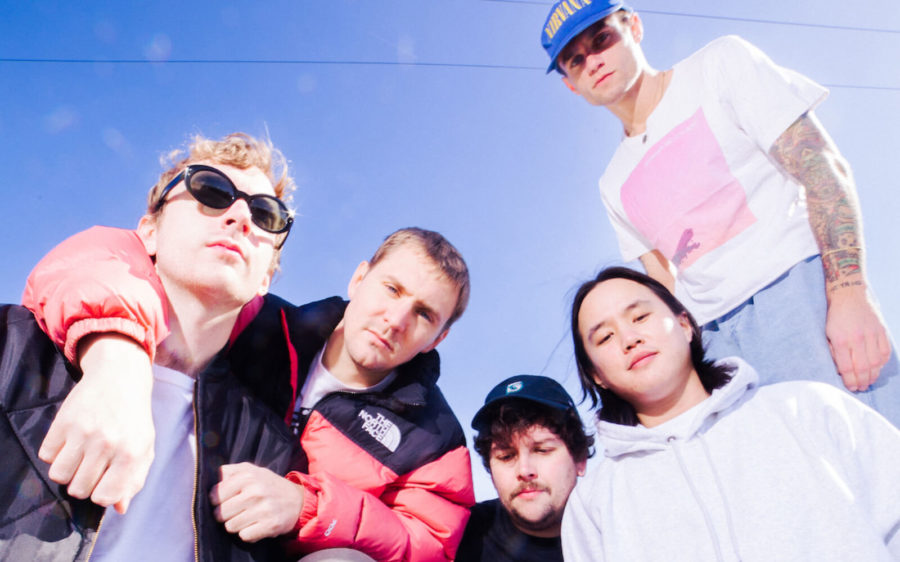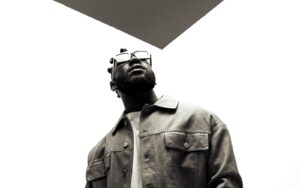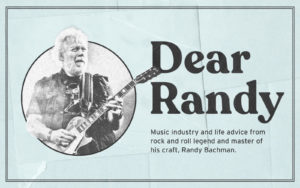“I was in physical agony…I had to crouch to be able to get into the shot, so I’m running and crouching and I’m doing it for hours on end,” Shelton recalls to RANGE. “It took me four days to recover from that. It was brutal…it was so pathetic watching me try to use the stairs, because my legs were so fucked up.”
Despite this, the video looks gorgeous. Shelton captured the performance through a landscape-widening anamorphic lens, something he admits might not play for the vertically-obsessed TikTok generation. Adding to the throwback aesthetic, Shelton wanted his band to tap into the vitality of a particularly iconic videography.
“It was very much meant to be an ode to the energy of Beastie Boys,” he explains. “There’s a video [1989’s “Shake Your Rump”] where they’re on a rooftop with three cameras set up, and it’s a seamless take of them singing from camera to camera. We ended up cutting and using different takes [in “Do It Faster”], but that was the jumping off point for the video.”
Shelton grew up in the Pacific Northwest — it’s where he formed political powerviolence outfit Regional Justice Center — though he moved to California a few years ago to pursue filmmaking full time. His productivity behind the lens ground to a halt once the pandemic hit, though, which led towards picking up a guitar and writing the first few Militarie Gun EPs on his own.
Since its solo origins, Militarie Gun has ballooned into a full-fledged band, currently comprising Shelton, guitarists Nick Cogan and William Acuña, and drummer Vince Nguyen. They’ve tracked countless tours with anyone from Spiritual Cramp to Limp Bizkit. Floating between the indie world and the mainstream, they’ve collaborated in the studio with Vancouver cult faves Woolworm, but also managed to track Life Under the Gun at Dave Grohl’s 606 Studios. The new album reflects all that and more, its dozen songs combining the spirit of hardcore with hooks informed by Third Eye Blind and the Beatles. And with a June 23 release date around the corner, Shelton and the gang are throwing themselves into the project full-force for the foreseeable future.
“There’s no time for anything else, really,” Shelton admits, though he’s taking the ride in stride. “It’s an all-consuming force, which I think is the proper thing that it should be. It’s this thing that I can’t stop doing!”
Shelton’s not too sure when he’ll hop back in the director’s chair — Militarie Gun are currently gearing up for a run of European summer dates, to be followed with a much-hyped fall North American tour with Santa Cruz hardcore outfit Scowl. Nevertheless, Shelton spent time with RANGE to gush over the compositionally ornate and violently absurd music videos that have inspired his own camera work.
This interview has been edited and condensed.
blink-182 “What’s My Age Again?”
(dir. Marcos Siega)
If we’re just talking about the first videos that grabbed you, I feel like “What’s My Age Again?” by blink-182 was one of the first videos I remember seeing. Same with “Break Stuff” by Limp Bizkit.
I was probably in third grade when [“What’s My Age Again?”] dropped, and it just seemed subversive. I mean, there’s nudity; it’s raw; they had tattoos, which was so much less common at the time. It seemed ludicrous that it could exist. And then the song is just so good, and also so silly. I think it really speaks to a kid in elementary school.
Has the vibe of that video informed any of the work you’ve done behind the lens?
I think the jokiness [has], to some degree. But my goal is more so to paint a picture with absurdity, rather than straight up comedy.
Indochine “College Boy”
(dir. Xavier Dolan)
Any time I go into creating a video, I watch “College Boy” by Indochine. This was directed by Xavier Dolan, a French-Canadian film director; [Indochine are] a French group.
The video is so fucking dark, but absurd at the same time. It’s about this kid being bullied, and then at the end the bullies string him up on a cross and start shooting him with guns. The cops come by, and the kids with guns are like “It’s his fault!” so then the cops start shooting the kid on the cross. It’s absurdly dark, but it’s comedic in the level of violence that it commits to. I don’t know if it was ever on TV— it’s a seven-minute video — but it’s got a lot of views. It’s cinematic, but it’s also shot 1:1, so it’s a square. It’s beautiful, and extreme, and comedic, and sad.
I think a similar theme [between the video and Militarie Gun] is feeling on the outs, or not connected to what everyone else is connected to. That’s very much what we [presented] with the cover art [for Life Under the Gun]. It’s meant to [show] someone struggling [ed. a person is buried under rubble in a busy thoroughfare] while everyone else goes on and lives their life, not paying attention to them.
Fiona Apple “Across the Universe”
(dir. Paul Thomas Anderson)
It’s a Beatles song with a video directed by Paul Thomas Anderson. That’s an insane concept! And Fiona Apple’s obviously so amazing.
Now that I’m thinking about it, it’s [also] someone not existing in the same world as all the violence and insanity that’s going [on] around [them]. That’s a common theme for the work that I enjoy. And it’s just this beautiful, loud video, even though [the sound of the violence is] muted.
One of the things PT Anderson is known for is having quite a handle on the long-take. Is that technique a part of this video as well?
A big part of it is big, long takes; the technical side of it is so crazy. I don’t even understand how they made some of these shots.
What’s the longest take you’ve put into one of your videos?
Because I work in low-budget, I’ve never really attempted a one-er. I [also] feel like it got really film school-y for a period of time, where everyone was obsessed with the one-er. There were so many terrible things, like, “Here’s a long shot,” but you’re like, “Yeah, but if you knew anything about filmmaking you would have broken up the shot. This is boring as shit!”
I’ve never tried to step to it, in all honesty, because I’ve never felt that I had the means to properly pull it off. You need a lot of extras; you need a lot of things to make a piece so interesting. The worst thing for me would be if I made a terrible one-er. I would feel stupid.
Salvatore Gonacci “Horse”
(dir. Vedran Rupic)
Again, this one’s very absurd. It’s for an electronic artist; I think he’s in the same sphere as Diplo. It’s a video where all these people are comically abusing animals. Like, someone’s punching a lion; someone’s hitting a panda with a car; someone’s shutting a door on a horse’s head — and it’s all rhythmic[ally aligned with the music]. By the mid-point of the video, the artist shows up and he punches all the people who are hurting the animals. It’s such a comedic video, and it [demonstrates] such a simple cause-and-effect. I love a simple set-up that feels gratifying once you get to the pay-off.
The animals are clearly not real in this; they’re CGI. Have you ever worked with graphics in that fashion?
I’ve never worked with legit CG. And I’ve never written it in because I never believed I’d have the financial backing to pull it off. I think it’ll only be a matter of time before we do something with it, though. I’d love to try it.
King Krule “Alone, Omen 3”
(dir. Jocelyn Anquetil)
A modern video I’ve been obsessed with is “Alone, Omen 3” by King Krule. The simplicity of it is what makes it so incredible. The opening shot is of Archy [Marshall], and he’s in the middle of a crowd. It seems like a really busy cityscape, but all the people step away and [it’s revealed] he’s on a pebble beach. That forced, fake reality is what’s so interesting. I’m sure they had money and hired all those extras, [but] you could do that for no money.
I also really do love a slow pace. I’m not into the super-cut, fast-paced music video thing. I would rather things be able to live in shots. Hopefully you’ve created something worth looking at for longer. This video is exactly that, where every shot is so compositionally well-done that it’s worth looking at for the length of the verse, the chorus, or whatever.
Fatboy Slim “Praise You”
(dir. Spike Jonze)
A huge influence, especially [towards] putting myself out there in music videos I’m directing. It’s a big influence [towards] how to step outside of yourself to interact with the world — not as a star, but as a character; not to be yourself, but to be whatever the video needs you to be.
I think it’s such a brave thing, what Spike Jonze did. Not only did he direct [the video], but he starred in it [as fictional dance troupe leader Richard Koufey]. They did so many auxiliary things [afterwards, too,] like performing at the MTV Music Video Awards. They treated the video as larger than life, even though it’s shot on this shitty camera. It proves that you really only need a strong subject to make a video.
Could a parallel be drawn between the way the troupe is performing for unsuspecting folks in the “Praise You” video, and the way that mask-wearing figure is dancing in various public settings in your video for Angel Du$t’s “Bang My Drum”?
Definitely. It’s kind of embarrassing…almost every video [treatment] starts with me being like, “we’re in public, and interacting with the public.” Like, I hate having to be there [i.e. filming in public]. I love the result, but I don’t want to have to be in public doing weird shit in front of people.
Red Hot Chili Peppers “Around the World”
(dir. Stéphane Sednaoui)
This one is just good proof that [all] you need [is] a band in a room. Like, the Chili Peppers are so incredible at moving and looking cool on camera. It doesn’t always have to be a super elevated concept; a band can just be a band.
Thinking back on videos like “Do It Faster,” does Militarie Gun look as cool as the Red Hot Chili Peppers when they’re on-camera?
Fuck no. We’re boring, but we’re trying to figure it out. It’s hard to shake the shyness, but I think, slowly and surely, we are. It takes a long time, though. By the point the Red Hot Chili Peppers had done that video, they’d been a band for damn near 20 years!
















